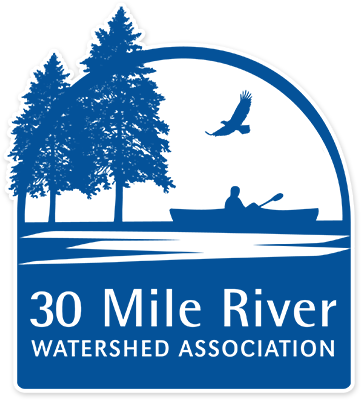High winds during this winter’s storms caused much damage to trees, breaking large limbs and taking entire trees to the ground. But what do we do when a tree falls IN the lake? We are asked this question often, as this is not an uncommon occurrence, and the answer has everything to do with WHERE and HOW the tree has fallen.
Unless the tree is near a private or public area or access, and therefore poses a threat to safety, or is blocking travel in/out of a public or private water access, the recommendation is to LEAVE THE TREE! Additions of large woody debris in lakes are common, natural, and provide important habitat for the fish and wildlife that live in and around it. However, if the tree is posing a safety hazard and/or blocking water access for use, then it can be removed, by the least invasive means possible, leaving the stump and root system in place, and with permission from Maine DEP and your local Code Enforcement Officer (CEO).
The rate and pattern in which trees fall in the lakes depend upon the types of trees along the shoreline and human activity. Fallen trees in lakes tend to be most abundant (dense) in smaller lakes with undeveloped shorelines. Larger lakes have higher wind and wave energy, which can break up trees faster and transport them offshore to deeper water. Human development often results in the removal of trees from shoreland areas. In a study of undeveloped lakes in northern Wisconsin and the upper peninsula of Michigan, (Christensen et al. 1996), researchers found that human impacts greatly reduced the abundance of trees in shallow, nearshore areas of lakes.

Photo source: Cottagelife.com
Understanding and embracing this phenomenon as a long-term renewable source of habitat is the first step! Shoreline trees are valuable to us on land as shoreline buffer vegetation, and then again in the water after they die while more trees are being regenerated. On many of our lakes, we have reduced or eliminated trees in shoreland areas – preventing them from becoming habitat in lakes. Another reason to be maintaining and improving robust stands of vegetation on our lake shorefronts!
“Ten thousand years ago, a tree grew on the shore of a lake somewhere in North America. For 140 years or more, fish swam in its shade and insects hatched on its branches and leaves; some were eaten by birds, some fell into the water to be eaten by fish, some survived to continue the cycle of life. Birds nested and foraged in its branches, perhaps kingfishers dropped like rocks, propelled by gravity to their next meal and eagles perched among its highest branches. A wood frog chorus would start each evening in spring near the first crotch, and often red squirrels would chatter for whatever reason red squirrels chatter. Then one day it happened: after years of increasing decay near the end of its life, the tree snapped at the butt during a windstorm, and fell with a thunderous crash into the lake; 140 years of silence and quiet rustling, punctuated by a single quick, loud finale. Within a minute, the waves that had acknowledged the tree’s entry into the water subsided, and all was quiet again.
Now the tree began its second life…in the lake. Within hours, crayfish crawled beneath its partially submerged trunk, to be followed by a mudpuppy and tadpoles, while minnows and small fish hovered within the lattice of its branches. Within days, perch, darters, sunfish, bass, burbot, pike and even walleye and muskellunge had also entered the complex network of the newly established community. Algae and diatoms began establishing colonies, while dragonfly nymphs and mayflies followed to forage among the branches. A wood duck competed with a softshell turtle for basking space on the bole that once contained its nest site cavity. Herons, green and blue, alternated use as well: the bole presented a fine place to access the fish below. Use of the tree by a variety of organisms would continue again for much longer than its life on land. Remarkably, the tree might last another 300 to 600 years, slowly changing shape over time as it yields to Father Time. Different organisms continue to use the tree until its cellulose has completely broken down and its chemical constituents have been fully integrated into the web of life in the lake.”
— An excerpt from A Second Life for Trees in Lakes – As Useful in the Water as They Were on Land by Michael A. Bozek, a publication of the Wisconsin Department of Natural Resources and University of Wisconsin Extension in partnership with the University of Wisconsin at Stevens Point.
